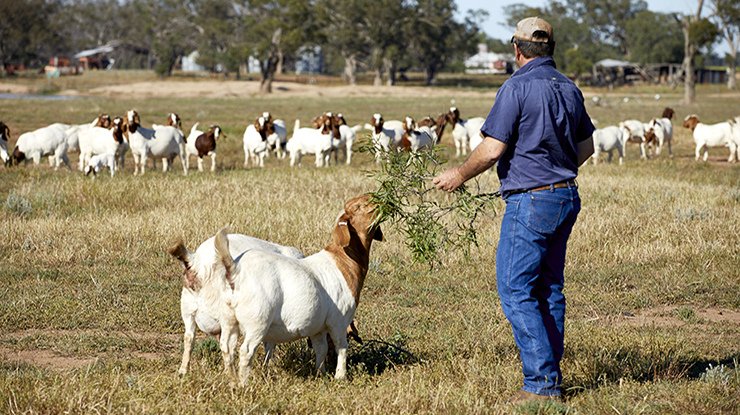
Goat herd rebuild underway
Key points
- Despite declines in both slaughter and production levels since the previous quarter, both are up on year-ago levels.
- Latest figures indicate producers are retaining breeding stock to rebuild their herds and transition from opportunistic rangeland harvesting to running more managed herds.
- MLA has launched a Goat Profitable Grazing Systems package, Getting goats to market: optimising rangeland goat production to support the industry.
The process of rebuilding Australia’s goat herd following years of drought is reflected in the latest June quarter data from the Australian Bureau of Statistics.
The data shows while both slaughter and production levels have declined since the previous quarter, they are both up on year-ago levels.
June quarter goat slaughter declined by 1.5% to hit 268,310 head. Despite the decline, slaughter was up 23% on the 2020 June quarter.
Production declined by 2% to hit 4,539 tonnes but was up 33% on year-ago quarter levels.
MLA Program Manager for Sheep and Goat Productivity, Joe Gebbels, said the latest figures indicated producers are retaining breeding stock to rebuild their herds and transition from opportunistic rangeland harvesting to running more managed herds.
“The June quarter saw slaughter in NSW and Queensland increase by 37%, hitting 11,767 and 85,170 head respectively, with WA slaughtered 1,171 head, a 532% increase,” Joe said.
“Victoria slaughtered 146,428 head in the June quarter.
“It has been great to see more producers managing their herds and letting the numbers build up. It has also been exciting to see a significant number of traditional sheepmeat or beef producers considering or actively getting into goats.”
Joe said goatmeat producers continued to show strong interest in refining their on-farm management systems.
“To support the industry, MLA has launched a Goat Profitable Grazing Systems (PGS) package, Getting goats to market: optimising rangeland goat production,” Joe said.
“PGS takes small groups of like-minded producers who want to improve their whole-farm performance and matches them with a deliverer who builds their knowledge, skills and experience through hands-on training.
“This PGS package was developed to build the knowledge and skills of goatmeat producers, allowing them to effectively and efficiently grow and select goats to generate profit.
“Through the package, producers are led through various activities that investigate the key profit drivers for goatmeat enterprises over five contact days and culminates in the development of an annual production plan to improve financial returns.
“The package also aims to develop an effective approach to learning that producers can use to drive ongoing improvement of their goatmeat enterprises.”



